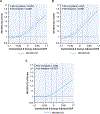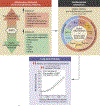Dietary Inflammatory Potential and Risk of Cardiovascular Disease Among Men and Women in the U.S
- PMID: 33153576
- PMCID: PMC7745775
- DOI: 10.1016/j.jacc.2020.09.535
Dietary Inflammatory Potential and Risk of Cardiovascular Disease Among Men and Women in the U.S
Abstract
Background: Inflammation plays an important role in cardiovascular disease (CVD) development. Diet modulates inflammation; however, it remains unknown whether dietary patterns with higher inflammatory potential are associated with long-term CVD risk.
Objectives: This study sought to examine whether proinflammatory diets are associated with increased CVD risk.
Methods: We prospectively followed 74,578 women from the Nurses' Health Study (NHS) (1984-2016), 91,656 women from the NHSII (1991-2015), and 43,911 men from the Health Professionals Follow-up Study (1986-2016) who were free of CVD and cancer at baseline. Diet was assessed by food frequency questionnaires every 4 years. The inflammatory potential of diet was evaluated using a food-based empirical dietary inflammatory pattern (EDIP) score that was pre-defined based on levels of 3 systemic inflammatory biomarkers.
Results: During 5,291,518 person-years of follow-up, we documented 15,837 incident CVD cases, including 9,794 coronary heart disease (CHD) cases and 6,174 strokes. In pooled analyses of the 3 cohorts, after adjustment for use of anti-inflammatory medications and CVD risk factors including body mass index, a higher dietary inflammatory potential, as indicated by higher EDIP scores, was associated with an increased risk of CVD (hazard ratio [HR] comparing the highest to lowest quintiles: 1.38; 95% confidence interval [CI]: 1.31 to 1.46; p for trend <0.001), CHD (HR: 1.46; 95% CI: 1.36 to 1.56; p for trend <0.001), and stroke (HR: 1.28; 95% CI: 1.17- to 1.39; p for trend <0.001). These associations were consistent across cohorts and between sexes, and they remained significant after further adjustment for other dietary quality indices. In a subset of study participants (n = 33,719), a higher EDIP was associated with a higher circulating profile of proinflammatory biomarkers, lower levels of adiponectin, and an unfavorable blood lipid profile (p < 0.001).
Conclusions: Dietary patterns with a higher proinflammatory potential were associated with higher CVD risk. Reducing the inflammatory potential of the diet may potentially provide an effective strategy for CVD prevention.
Keywords: cardiovascular disease; chronic inflammation; coronary heart disease; dietary patterns; predictive biomarkers; stroke.
Copyright © 2020 American College of Cardiology Foundation. Published by Elsevier Inc. All rights reserved.
Conflict of interest statement
Author Relationship With Industry The Nurses’ Health Studies and Health Professional Follow-up Studies are supported by National Institutes of Health grants U01 CA186107, R01 CA49449, R01 HL034594, R01 HL088521, U01 CA176726, R01 CA49449, U01 CA167552, R01 HL60712, and R01 HL35464. Dr. Li was supported by grants from the National Institute of Diabetes and Digestive and Kidney Diseases (K99 DK122128) and Boston Nutrition Obesity Research Center (2P30DK046200-26). Dr. Tabung was supported by R00 CA207736. Dr. Yanping Li has received research support from the California Walnut Commission and SwissRe Research Foundation. All other authors have reported that they have no relationships relevant to the contents of this paper to disclose.
Figures




Comment in
-
Ideal Dietary Patterns and Foods to Prevent Cardiovascular Disease: Beware of Their Anti-Inflammatory Potential.J Am Coll Cardiol. 2020 Nov 10;76(19):2194-2196. doi: 10.1016/j.jacc.2020.09.575. J Am Coll Cardiol. 2020. PMID: 33153577 No abstract available.
-
Food as Medicine: Prevention Is Better, but Could It Cure?J Am Coll Cardiol. 2021 Mar 9;77(9):1267. doi: 10.1016/j.jacc.2020.11.078. J Am Coll Cardiol. 2021. PMID: 33663746 No abstract available.
-
Reply: Food as Medicine: Prevention Is Better, but Could It Cure?J Am Coll Cardiol. 2021 Mar 9;77(9):1267-1268. doi: 10.1016/j.jacc.2020.12.049. J Am Coll Cardiol. 2021. PMID: 33663747 No abstract available.
References
-
- Hansson GK. Inflammation, atherosclerosis, and coronary artery disease. N Engl J Med 2005;352: 1685–95. - PubMed
-
- Libby P. Inflammation and cardiovascular disease mechanisms. Am J Clin Nutr 2006;83: 456S–60S. - PubMed
-
- Libby P, Ridker PM, Maseri A. Inflammation and atherosclerosis. Circulation 2002;105:1135–43. - PubMed
-
- Pearson TA, Mensah GA, Alexander RW, et al. Markers of inflammation and cardiovascular disease. Circulation 2003;107:499–511. - PubMed
Publication types
MeSH terms
Substances
Grants and funding
LinkOut - more resources
Full Text Sources

